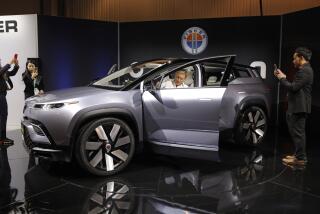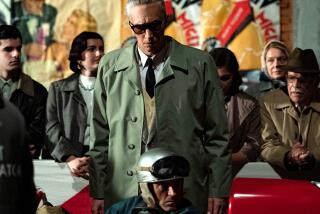Car review: Jaguar sets bar high for 2014 F-Type
In a 1961 debut that reverberated worldwide, Jaguar pulled the covers off its E-Type coupe at the Geneva Motor Show and redefined beauty in automobiles.
In the era of audacious tail fins and unchecked mass, the sensual 1961 E-Type, also known as the XKE, offered a simple elegance. The coupe’s designer was chasing aerodynamics, but in the Jag’s sleek profile he created art. Quite literally: The Museum of Modern Art in New York has had an E-Type in its permanent collection since 1996.
Enzo Ferrari is said to have wept upon viewing the E-Type, calling it the most beautiful car ever made. The Italian sports cars bearing his name would soon incorporate the Jag’s design elements.
Fifty-two years later, the ripples from that Geneva debut are bringing to our shores another all-new car from Jaguar. This week, the venerable British brand put the 2014 F-Type convertible on sale.
The two-seater fetches $70,000 to $100,000, and a coupe variant is all but confirmed for 2014. Both versions will occupy a market niche that overlaps with the Porsche Boxster S and the 911.
The car was designed by Ian Callum, whose pen has also given us Jaguar’s mid-size XF and full-size XJ sedans, along with the Aston Martin DB7 and DB9. Although Callum started working on the F-Type before Jaguar had decided what to call it, the automaker is billing the F-Type as the spiritual successor to the E-Type.
Forcing the F-Type to follow such a legendary act presents a big risk. The new F-Type may not find itself in art museums decades from now, but Jaguar has clearly scored with a gorgeous machine that is capable of shouldering the brand’s heritage of performance and sex appeal.
The company could use the help.
The flip side of Jaguar’s heritage involves large pools of oil in driveways and even larger repair bills, with the predictable effect on resale values for most models. (The E-Type remains the exception, a prized and expensive collector car.) Although Jaguar is midway through a dramatic aesthetic makeover, reliability ratings and sales figures have yet to catch up.
J.D. Power & Associates ranked Jaguar fifth from the bottom in dependability for 2012. Consumer Reports rated both the 2012 Jaguar full-size XJ and mid-size XF sedans as having “much worse than average” predicted reliability.
Meanwhile, the automaker’s sales lag far behind those of competitors. Last year, Jaguar — now owned by India’s Tata Motors — reported that it sold just 55,675 vehicles in the U.S. That’s in contrast to luxury leaders BMW and Mercedes-Benz, which each sold about five times that many cars.
Yet even if this F-Type turns out to be a marked success — and there’s no reason it shouldn’t — it won’t move the sales needle in a meaningful way for Jaguar. Tom Libby, a senior forecasting analyst at auto research firm R.L. Polk & Co., predicts that Jaguar probably will sell about 6,000 F-Types in 2014.
“In terms of competing with the Germans, it doesn’t help much,” Libby said. “Obviously, it’s a terrific car in terms of image and performance, but they’re not going to sell them on a large scale.”
What will help is a much-rumored yet unconfirmed compact sedan — think BMW 3-Series rival — and a crossover SUV. Those two segments sell vehicles at the highest volume in the luxury world. Jaguar is well aware of these conspicuous holes, Callum said.
“We’ve been fairly open about that, that we are going to increase our car lineup,” Callum said. “We have to. We have to become a big player. We’re just not big enough at the moment to have the gravitas on the average street, to have the recognition.”
But the F-Type can certainly make an impact on the brand’s image, drawing more attention to other offerings in the lineup and helping to define Jaguar’s design language for future models.
Going fast helps too. The F-Type is available with one of three direct-injected, supercharged engine variants.
The base offering is a direct-injected 3.0-liter supercharged V-6 that makes 340 horsepower and 332 pound-feet of torque. This model starts at $69,895 and Jaguar says it will do zero to 60 mph in 5.1 seconds.
Then there’s the F-Type S, which we tested because Jaguar expects it to be its volume seller of the trio. This model starts at $81,895 and comes with a more powerful version of the same engine, with 380 horsepower and 339 pound-feet of torque. Acceleration to 60 mph drops to 4.8 seconds.
At the top of the heap is the F-Type V8 S. For $92,895, buyers get an all-aluminum 5.0-liter V-8 that makes 495 horsepower and 460 pound-feet of torque.
All the cars come with an eight-speed automatic transmission with manual paddle shifters and a sport mode. Jaguar may offer a manual version later, but the automaker knows most drivers are likely to select the automatic option — and it’s a good one.
In full manual mode, the transmission is easily one of the fastest-shifting automatics available. Adding to the joy are enthusiastic throttle blips on downshifts, mixed with the aggressive popping and crackling of the sport-tuned exhaust.
In any driving situation, the transmission and engine work together in a remarkably silken performance. The duo accelerates as smoothly as you’d hope from a car this handsome, and throws out a robust exhaust note that’s worthy of a car costing twice this much.
At 3,558 pounds, the car isn’t exactly light, but it never feels cumbersome. Its horsepower-to-weight ratio puts it between the Porsche Boxster S and 911. Helping keep weight down is an all-aluminum chassis and body panels.
In terms of raw performance, the F-Type feels less visceral and immediate than the Boxster S or 911, and it probably would lose to either on a track. But this is an everyday sports car that’s comfortable, smooth and effortlessly quick; it’s as much car as 90% of buyers in this segment will ever need or want.
And they’ll never get tired of looking at it. The front bears a passing resemblance to Jaguar’s larger XK, with a large, oval-shaped grille flanked by a pair of air inlets on either side. The car is smaller than pictures suggest — 3 inches shorter than a Honda Civic — and hugs the ground with a wide, low stance. A subtle shoulder line, which recalls the E-Type, arcs over the rear wheels and draws your eyes to the F-Type’s stunning rear end.
The taillamps also recall the F-Type’s ancestor. Ultra-thin horizontal LED lights wrap around the rear corners from each side, converging in the silhouette of two round taillights near the license plate.
At the bottom of the bumper is an aggressive yet tasteful fascia that serves as the only distinction between the V-6 and V-8 models. The F-Type and F-Type S feature a pair of center-mounted chrome exhaust pipes that look as good as they sound. V-8 models have two sets of dual tips on either side of the fascia.
The genius of the F-Type’s design, especially the rear, is it looks unlike anything else on the road while giving a subtle nod to Jaguar’s past glory. A week of driving in car-saturated Los Angeles yielded numerous cheers, furtive photos at stoplights and shouted inquiries on the freeway.
“Overall, from the back of this car, it’s something that’s very exciting,” Callum said. “And incidentally, that’s the view most people are going to see.”
david.undercoffler@latimes.com
::
2014 Jaguar F-Type S at a glance
Times’ take: Jaguar brings sexy back
Highs: To-die-for looks, smooth drivetrain
Lows: Small trunk, not cheap
Vehicle type: Two-door, two-passenger convertible
Base price: $81,895
Price as tested: $91,965
Powertrain: 3.0-liter supercharged V-6 engine; rear-wheel drive
Transmission: Eight-speed automatic with manual shifting
Horsepower: 380
Torque: 339 pound-feet
Zero to 60 mph: 4.8 seconds, according to Jaguar
EPA fuel economy rating: 19 mpg city / 27 highway







